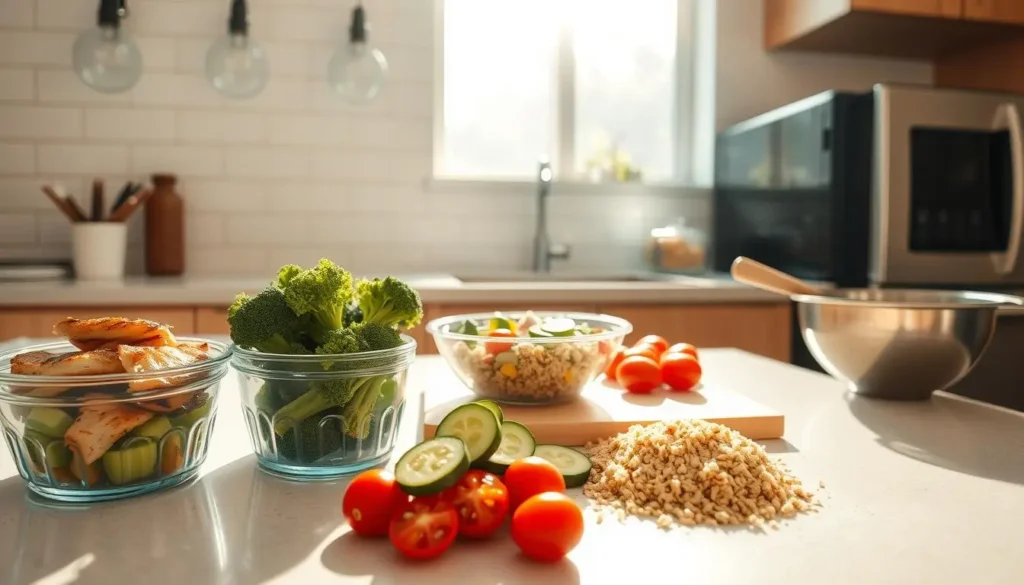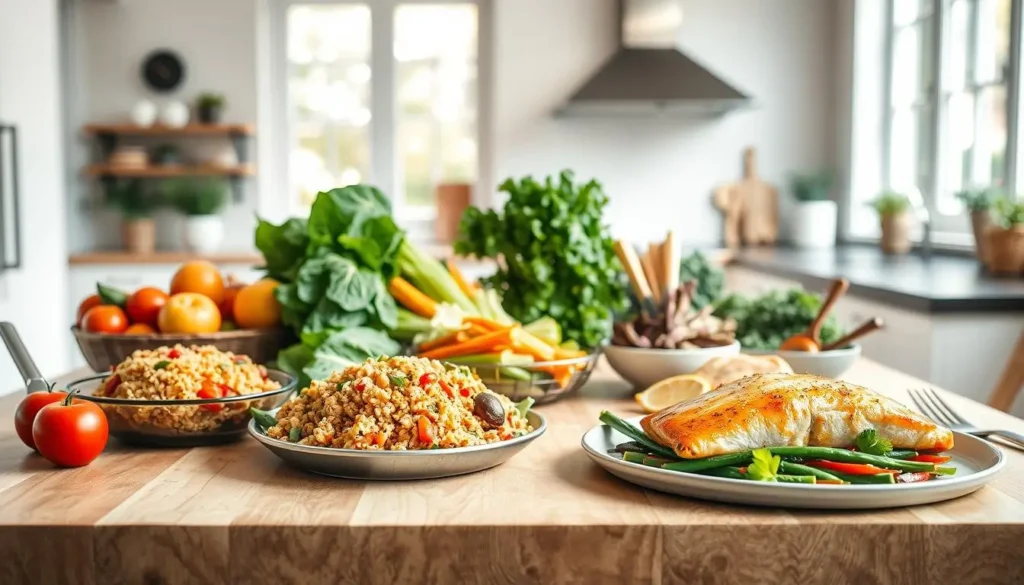Meal Prep Made Easy: Healthy Dinners for the Week Ahead
Are you tired of deciding what’s for dinner every day? Meal prep can change your life, making home-cooked meals easy. Spend a few hours on meal prep and enjoy healthy dinner ideas all week.

Engaging in meal preparation not only conserves time but also reduces waste and promotes healthier eating habits. It’s about planning, using the right tools, and knowing what makes a meal balanced.
We’ll show you how to make meal prep fun and simple.
Table of Contents
Key Takeaways
- Discover the benefits of meal prep for busy households.
- Learn how to plan and prepare healthy dinners in advance.
- Understand the importance of nutritional balance in meal prep.
- Explore practical tips for making meal prep a sustainable habit.
- Get introduced to various healthy dinner ideas to keep your meals exciting.
The Benefits of Meal Prepping for Busy Lifestyles
Busy lives need quick solutions, and meal prepping is a top choice. It saves time and lets you eat healthy without daily cooking stress. Dedicating a few hours each week to this practice can yield significant benefits.
Time-Saving Advantages
Meal prepping is a big time-saver. Cooking in bulk means you cook less during the week. This frees up time for other things. Plus, you can prep ingredients ahead, making meals easy to put together.
Financial Benefits
Meal prepping also saves money. Buying in bulk and planning meals around sales cuts down grocery costs. It also stops you from spending on last-minute takeout or dining out.
Reduced Food Waste
Meal planning helps avoid buying too much, which means less waste. You use up all your ingredients, saving money and reducing waste.
Adding meal prepping to your routine makes life easier, cheaper, and healthier. Start small and see how it improves your busy life.
Essential Kitchen Tools for Efficient Meal Preparation
Having the right kitchen tools is key for quick meal prep. The right gadgets and equipment make cooking easier and fun. This way, you can enjoy making meals without stress.
Storage Containers
Good-quality meal prep containers are a must. It is advisable to select containers that are airtight, microwave-safe, and dishwasher-friendly for optimal convenience. They make storing and reheating meals simple and stress-free.
Time-Saving Appliances
Appliances like slow cookers, instant pots, and food processors save a lot of time. They let you cook many dishes fast and with little effort.
Cooking Utensils
The right cooking utensils are crucial. You’ll need a chef’s knife, cutting boards, and spatulas. These tools help you chop ingredients well and cook meals perfectly.
| Tool | Purpose |
|---|---|
| Meal Prep Containers | Storing and reheating meals |
| Slow Cooker | Cooking meals over a long period |
| Chef’s Knife | Chopping ingredients |
Planning Your Weekly Meal Prep Schedule
Effective meal prep starts with a well-planned schedule. To achieve a seamless meal prep experience, it’s crucial to organize your meals for the week ahead. This involves several key steps that help streamline your cooking process and ensure you’re making the most of your time and resources.
Creating a Meal Calendar
Start by creating a meal calendar. This visual tool allows you to plan out your meals for the week, including breakfast, lunch, dinner, and any snacks. By having a clear overview of your meal plan, you can avoid last-minute takeouts and ensure you’re staying on track with your dietary goals. Consider using a digital calendar or a physical planner, whichever suits your preference.
Shopping List Organization
Once you have your meal calendar in place, the next step is to organize your shopping list. Make a list of all the ingredients you’ll need for your meals and stick to it when you’re at the grocery store. This helps prevent impulse buys and reduces food waste. You can use apps or traditional pen and paper for this task.
Budgeting Tips
Budgeting is a critical aspect of meal prep. Additionally, by organizing your meals based on grocery store sales, you can effectively manage your expenses. Consider buying in bulk and using coupons to further reduce your expenses. As Ramsey says,
As the saying goes, ‘A budget is telling your money where to go instead of wondering where it went.’
Effective budgeting ensures that your meal prep is not only healthy but also financially sustainable.
By following these steps, you can create a meal prep schedule that is both efficient and cost-effective, setting you up for success in the kitchen.
Nutritional Foundations: Building Balanced Meals
To make healthy dinners, focus on nutritional balance. Include different food groups in your meals. A balanced meal has protein, complex carbs, healthy fats, and lots of veggies and fruits.
Protein Sources
Protein is key for muscle growth and repair. You can use lean meats, fish, eggs, tofu, and legumes in your meals.
Complex Carbohydrates
Complex carbs give you lasting energy and are full of fiber, vitamins, and minerals. Add whole grains like brown rice, quinoa, and whole wheat bread to your meals.
Healthy Fats
Healthy fats are important for your brain and help you absorb vitamins. Incorporating foods such as nuts, seeds, avocados, and olive oil into your diet can provide excellent sources of healthy fats.
Vegetables and Fruits
Vegetables and fruits add vitamins, minerals, and antioxidants to your meals. Try to have a variety of colors on your plate. Include leafy greens, cruciferous veggies, and fruits like berries and apples.
By focusing on these nutritional basics, you can make balanced dinners that are good for your health. For example, try grilled chicken with quinoa and roasted veggies, topped with a citrus vinaigrette.
- Incorporate a variety of protein sources to keep meals interesting.
- Use whole grains as your primary source of complex carbohydrates.
- Add healthy fats like nuts and avocados to enhance flavor and nutrition.
- Include a wide range of vegetables and fruits to ensure a broad spectrum of vitamins and minerals.
Time-Efficient Meal Prep Strategies
There are simple ways to make meal prep faster. These methods help you save time and eat healthy all week.
Batch Cooking Techniques
Batch cooking means making lots of one thing or a whole meal at once. It’s great for when you’re really busy. For instance, cooking a big batch of rice or quinoa can be used in many meals.
Component Prepping
Component prepping is about getting ready the parts of a meal. This could be chopping veggies, marinating meats, or cooking grains. Having these parts ready lets you quickly make meals.
One-Hour Prep Sessions
Spending just one hour a week on meal prep can really help. Use this time to prep a few key meals or parts that you can mix and match all week.
| Strategy | Description | Benefits |
|---|---|---|
| Batch Cooking | Cooking large quantities of a single ingredient or meal | Saves time, reduces food waste |
| Component Prepping | Preparing individual components of a meal | Quick meal assembly, increased variety |
| One-Hour Prep Sessions | Dedicated meal prep time | Efficient use of time, reduced stress |
Using these quick meal prep strategies, you can enjoy quick healthy dinner options without spending hours cooking. Whether you pick batch cooking, component prepping, or one-hour prep sessions, you’ll streamline your meal prep.
15 Healthy Dinner Ideas for Your Weekly Meal Prep
Ready to spice up your meal prep? Try 15 tasty and healthy dinner ideas for the week. Meal prep doesn’t have to be dull. Mix quick sheet pan meals, one-pot wonders, and casseroles for different tastes and textures all week.
Quick Sheet Pan Meals
Sheet pan meals are perfect for busy nights. They’re easy to make, clean up is minimal, and you can use your favorite ingredients. Here are some ideas:
- Roasted Chicken and Vegetables: Toss chicken, broccoli, carrots, and sweet potatoes with olive oil, salt, and pepper. Roast at 425°F for 30 minutes.
- Salmon and Asparagus: Season salmon and asparagus with lemon juice and herbs. Roast at 400°F for 12-15 minutes.
- Vegetarian Delight: Mix cauliflower, Brussels sprouts, and red onion with olive oil and spices. Roast at 425°F for 25-30 minutes.
One-Pot Wonders
One-pot meals are great for meal prep. They’re easy to cook, clean up is minimal, and you can reheat them later. Here are some one-pot wonders to try:
- Quinoa and Black Bean Bowl: Cook quinoa, black beans, diced tomatoes, and vegetable broth in one pot. Season with cumin and chili powder.
- Chicken and Rice Casserole: Cook chicken, rice, and chicken broth in a large pot. Add frozen peas and carrots for extra flavor.
- Lentil Soup: Saute onions, carrots, and celery, then add lentils, broth, and diced tomatoes. Simmer until the lentils are tender.
Make-Ahead Casseroles
Casseroles are perfect for meal prep. They can be made ahead, refrigerated or frozen, and baked when you need them. Here are some casserole ideas:
- Chicken and Broccoli Casserole: Mix cooked chicken, steamed broccoli, and a creamy sauce. Top with cheese and breadcrumbs. Bake at 375°F for 25-30 minutes.
- Veggie Lasagna: Layer lasagna noodles, marinara sauce, and sautéed vegetables and ricotta cheese. Top with mozzarella and parmesan cheese.
- Breakfast Casserole: Whisk eggs, milk, and diced vegetables, then add cooked sausage or bacon. Pour into a baking dish and refrigerate overnight. Bake at 350°F for 35-40 minutes.
These 15 healthy dinner ideas are a great start for your meal prep journey. With a mix of quick sheet pan meals, one-pot wonders, and casseroles, you’ll enjoy a variety of healthy meals all week.
Protein-Packed Vegetarian Meal Prep Recipes
Meal prep just got a whole lot tastier with these protein-rich vegetarian recipes. They will keep you fueled all week long. As a vegetarian, it’s key to include various protein sources for good health. Here, we’ll look at some tasty and healthy options.
Legume-Based Dishes
Legumes are a top protein choice for vegetarians. They’re versatile and can be used in many dishes, like soups and salads. Try making a big batch of lentil soup or chickpea salad for the week. Legume-based dishes are not only high in protein but also rich in fiber and essential nutrients.
Tofu and Tempeh Recipes
Tofu and tempeh are great protein sources that can be marinated, baked, or stir-fried. They soak up flavors well, making them perfect for many meals. Consider prepping a few blocks of tofu or tempeh with different marinades for a quick protein boost. Marinating tofu or tempeh before baking can enhance its flavor and texture.
Grain Bowl Combinations
Grain bowls are a fantastic way to mix protein-rich ingredients with complex carbs and healthy fats. Try mixing cooked quinoa with roasted veggies, chickpeas, and a dollop of tahini sauce for a nutritious meal. Grain bowls are highly customizable and can be adjusted based on your dietary preferences.
By adding these protein-packed vegetarian meal prep recipes to your routine, you’ll easily maintain a balanced diet. Experiment with different ingredients and flavors to keep your meals exciting and satisfying.
Low-Calorie Dinner Options That Don’t Sacrifice Flavor
Learn to make delicious, low-calorie dinners that taste amazing. You don’t have to pick between healthy food and tasty meals. With the right ingredients and techniques, you can enjoy both.
Vegetable-Forward Recipes
Using more vegetables is a smart way to cut calories without losing flavor. Roasted vegetables are especially good because they become sweet. Try a roasted vegetable quinoa bowl with bell peppers, zucchini, and carrots.
You can also grill or sauté veggies to add texture and taste to your meals.

Lean Protein Options
Adding lean proteins to your meals helps keep calories low but still packs nutrients. Chicken breast, turkey, and fish are all good choices. For those who don’t eat meat, legumes, tofu, and tempeh are great options.
Grilling or baking these proteins with herbs and spices makes them taste better without extra calories.
Flavor-Boosting Techniques
To make your low-calorie dinners taste great, use herbs, spices, and citrus. Marinating your proteins or veggies before cooking adds flavor. Also, using broth or stock in cooking makes dishes richer.
Try different seasoning mixes to find new favorite tastes.
Make-Ahead Sauces and Marinades to Elevate Your Meals
Make your meal prep more exciting with make-ahead sauces and marinades. They add flavor and variety to your dishes. These simple additions can turn a basic meal into a feast for the taste buds.
Versatile Marinades
Marinades are perfect for adding flavor to proteins and veggies. You can whip up a big batch on the weekend. Then, use it all week to marinate different foods. Olive oil, lemon juice, garlic, and herbs like thyme and rosemary are great ingredients.
Healthy Dressings
You don’t need to buy store-bought dressings full of preservatives. Make your own using Greek yogurt, avocado, and herbs. These dressings keep well in the fridge for up to a week.
Flavor-Packed Sauces
Sauces like teriyaki, salsa, and tzatziki bring a burst of flavor to your meals. Make them ahead and store them in the fridge or freezer. Just reheat or thaw when you’re ready to serve.
Adding make-ahead sauces and marinades to your meal prep routine brings variety and excitement. You don’t have to give up health or flavor.
Proper Food Storage and Safety Guidelines
Proper food storage is key to successful meal prep. It keeps your meals safe to eat. Always follow safety guidelines to avoid foodborne illnesses.
Container Selection
Choosing the right containers is crucial. Look for ones that are airtight, leak-proof, and safe. Use glass or BPA-free plastic for the best results.
Refrigeration Guidelines
Keeping your meal prep in the fridge correctly is important. Make sure your fridge is at or below 40°F (4°C). Use shallow containers to cool food faster. Eat or freeze within 3 to 4 days.
Freezer-Friendly Meals
Freezing is great for longer storage. Use airtight, freezer-safe containers or bags to avoid freezer burn. Always label containers with the date and what’s inside. Follow the “first in, first out” rule.
| Storage Method | Temperature | Duration |
|---|---|---|
| Refrigeration | ≤40°F (4°C) | 3-4 days |
| Freezing | 0°F (-18°C) | 3-4 months |
Avoiding Meal Prep Burnout: Creating Variety and Flexibility
Keeping your meal prep interesting is key to avoiding boredom. By using a few simple strategies, you can make sure your meals stay fresh and exciting all week long.
Rotating Meal Plans
Rotating your meal plans is a great way to avoid burnout. Change your menu every few weeks to try new recipes and cuisines. Look online or use cookbooks for inspiration. For example, you might focus on Italian food one week and Mexican the next.
Repurposing Leftovers
Turning leftovers into new meals is another smart move. Instead of eating the same thing over and over, get creative. Last night’s chicken can become chicken salad or soup. Creativity is key here.
Theme Nights
Theme nights can make meal prep more fun. Try having “Taco Tuesday” or “Stir-Fry Friday.” This adds variety and something to look forward to.
| Theme Night | Meal Prep Idea |
|---|---|
| Taco Tuesday | Prepare taco fillings, such as seasoned ground beef, chicken, or beans, along with toppings like salsa, avocado, and sour cream. |
| Stir-Fry Friday | Marinate proteins like chicken or tofu and prep a variety of vegetables, such as bell peppers, broccoli, and carrots, for a quick stir-fry. |
Using these strategies, you can keep your meal prep exciting and fun. This way, you avoid the boredom that comes from eating the same thing every day.
Conclusion: Transforming Your Weekly Dinner Routine
Adding meal prep to your life can change your weekly dinners for the better. It makes them healthier and more efficient. This article has given you the tools to create a dinner plan that fits your lifestyle.
Meal prep has many advantages. It saves time, cuts down on food waste, and helps you eat better. By planning meals and using the right kitchen tools, you can make cooking easier and faster.
It’s time to use what you’ve learned and start making your dinners healthier and more organized. With a bit of creativity and planning, you can make a big difference. This change will not only improve your dinners but also your overall health.
FAQ
What are some easy healthy meals I can prep for dinner?
You can prep many easy healthy meals. Try sheet pan chicken and veggies, one-pot pasta, or casseroles. These meals are tasty and full of nutrients.
How do I plan a weekly meal prep schedule?
Start by making a meal calendar and a shopping list. Set a budget too. Then, pick days for meal prep and cooking.
What are some essential kitchen tools for meal prep?
You’ll need containers, appliances like slow cookers, and cooking tools like knives. These tools make meal prep easier.
How can I ensure my meal prep is nutritious and balanced?
Include protein, complex carbs, healthy fats, and veggies and fruits. This mix gives you all the nutrients for a healthy diet.
What are some low-calorie dinner ideas that are flavorful?
Use veggie-forward recipes and lean proteins. Roasting or grilling adds flavor without extra calories.
How can I avoid meal prep burnout?
Change your meal plans, use leftovers, and have theme nights. This variety keeps meal prep fun and engaging.
What are some tips for proper food storage and safety?
Choose the right containers and follow fridge and freezer rules. This keeps your food safe and fresh.
Can I meal prep if I have a busy lifestyle?
Yes, meal prep is great for busy lives. It saves time, cuts costs, and reduces waste.
How can I make meal prep more efficient?
Use batch cooking, prep components, and do one-hour prep sessions. These methods make healthy meals quick and easy.
What are some protein-packed vegetarian meal prep recipes?
Try dishes with legumes, tofu, and tempeh, and grain bowls. These options are tasty and nutritious.

